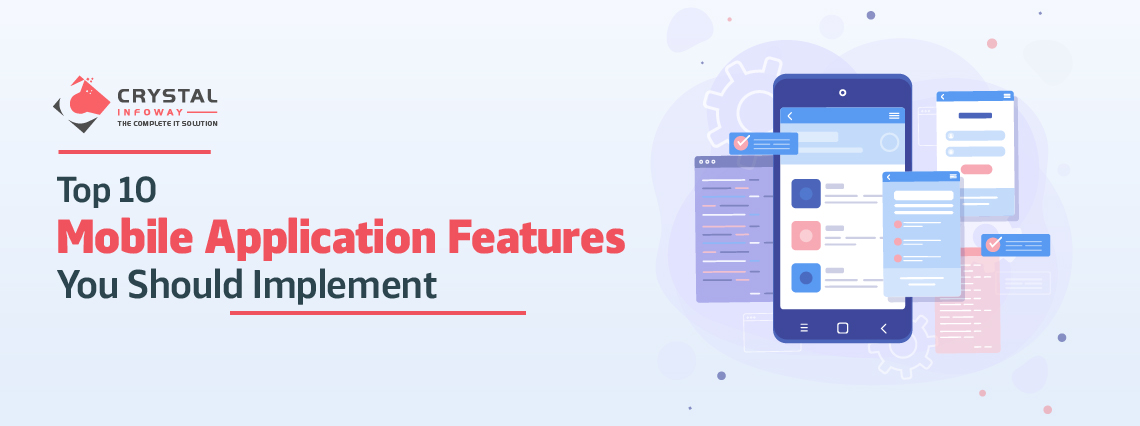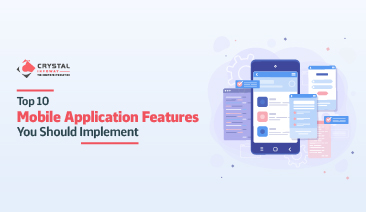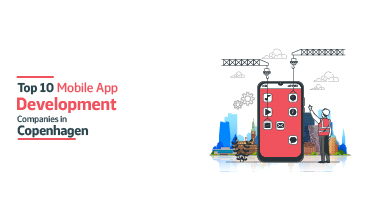
Request a Call Back
Enter your contact details and one of our friendly team member will be in touch soon!.

Enter your contact details and one of our friendly team member will be in touch soon!.

Having a great mobile application is essential in today’s digital world, and the features you choose to include can make or break your success. With the right features, you can increase user engagement, monetize your app more effectively, and improve user experience. To help you get started on creating an effective mobile app, here are 10 key features that should be included in any successful mobile application: In-app Subscriptions, Social Login, Push Notifications, Analytics & User Tracking, Cloud Integration Voice Recognition, In-app Payments, AI & Machine Learning and Multiplatform Support. By implementing these features into your mobile app development plan early on in the process you'll have a much better chance of achieving success with your product.
In-app subscriptions are a great way to monetize your mobile app and keep users engaged. By offering in-app subscriptions, you can provide access to exclusive content or features, such as premium levels or limited-time discounts. To set up an in-app subscription, you must use a payment gateway supporting this feature. There are many popular payment gateways available for mobile applications like Stripe and Apple Pay which integrate with both IOS and Android apps. Once integrated into your app, customers will be able to choose the plan they would like to subscribe to and make payments directly from within the application.
In addition to providing additional income streams for developers, there are several benefits associated with offering in-app subscriptions as well. Firstly, it allows developers more control over user experience since they can tailor what kind of content is provided based on subscription plans chosen by the user. Secondly, it gives them more insight into their customer base so they can better understand what type of content resonates with their audience and focus on creating products accordingly. Finally, it helps build brand loyalty as customers have already invested money in subscribing making them less likely to go elsewhere if something new comes out on the market
Social login is a great way to enable users to quickly and easily sign into your mobile app. Allowing users to use their existing social media accounts, removes the need for them to create new profiles or remember long passwords. This makes it easier for customers to access the information they need, reducing friction in the onboarding process which can lead to higher user retention.
There are many benefits associated with implementing social login within your mobile application. Firstly, you can get detailed analytics about each user as well as insights into their preferences which can be used for targeted marketing efforts. Additionally, it helps protect against fraudulent activity by enabling more secure authentication processes than traditional methods such as SMS verification codes or email confirmations. Finally, offering social login allows developers to access a larger customer base since users may prefer using one platform over another when signing up for an account.
To ensure that customers have a smooth experience when signing up via social networks there are some key tips that developers should keep in mind: make sure any required permissions from the third-party platforms are clearly outlined and explained; provide clear instructions on how users can complete the connection process; consider adding options like linking multiple accounts together so that customers don’t have log out and back in every time they want to switch between different services; and lastly test your implementation thoroughly before launch so you know everything works properly from day one!
Push notifications are a powerful tool for engaging users and reminding them of your app. They can be used to keep users up-to-date on the latest news, provide helpful reminders, and even encourage people to take action within the app such as making a purchase or completing a task. It’s important however to make sure that any push notifications sent out are useful and relevant so that they don’t end up annoying customers instead of helping them.
When deciding how often and what type of push notifications you should send, it is important to consider user preferences as well as the goals you have set for your mobile application. For example, some apps may benefit more from sending daily updates while others might want to focus on weekly content releases or timely announcements about special promotions or events. Additionally, consider segmenting users based on their interests so that each group receives tailored messages related to their needs which will help boost engagement levels over time.
For push notifications to be effective it is also necessary for developers to pay attention not only when sending messages but also when responding in case someone does interact with one of the alerts sent out by your app. This could include replying directly with an answer if a customer asks something via a notification or providing additional information about an offer mentioned in the message itself – this helps create better relationships between brands and customers which can lead to increased loyalty and longer-term success!
Analytics and user tracking are essential for understanding how customers interact with your mobile application. By having access to detailed data about user behavior, you can better optimize the experience of using your product as well as identify areas where further improvements could be made. This will help ensure that users have a positive experience when using your app, leading to increased customer retention rates and higher levels of engagement over time.
When implementing analytics and user tracking in mobile applications it is important to consider best practices such as ensuring that any collected data is relevant to improving the end-user experience; making sure information remains secure; allowing customers the option to opt-out if they wish; being transparent in how their data will be used; and notifying users before changes occur or new features become available which may affect them. Additionally, regular reviews should be conducted on all gathered metrics so developers can adjust their approach accordingly based on the results they find.
Finally, by combining both qualitative (e. g interviews) and quantitative (e. g usage statistics) research methods it’s possible to gain even more insights into what makes an effective mobile application – this can provide valuable feedback which can then be used towards future development efforts in order create successful products with high customer satisfaction ratings!
Integrating cloud technology into a mobile application can be an incredibly powerful tool for developers. By utilizing the scalability and flexibility of cloud-based services, you can quickly create and deploy apps that provide a better performance, reliability, and cost efficiency than traditional on-premise solutions.
One of the main advantages of integrating the cloud into your app is improved scalability since it allows you to easily expand or contract resources as needed without having to invest in additional hardware or software. Additionally, users will benefit from enhanced security measures such as encryption which helps keep their data safe even when stored remotely. Finally, by taking advantage of various storage options available with different providers (e. g block storage from AWS), apps can reduce costs associated with managing large datasets while still providing quick access times for customers.
When setting up your app’s integration with the cloud there are several things you need to consider to ensure a successful implementation: understanding what type of workloads are best suited for this architecture; researching different service providers and making sure they offer features that meet your needs; deploying a secure environment using industry-standard protocols such as SSL/TLS; testing out any APIs used so they work properly across all platforms; monitoring usage metrics regularly to prevent unexpected downtime or resource exhaustion issues; and finally setting up failover plans should something go wrong during peak hours or in the event of major disasters like natural disasters which could disrupt normal operations.
Voice recognition technology has become increasingly popular in recent years and is quickly becoming a must-have for most mobile applications. By leveraging this technology, developers can create an engaging user experience that allows customers to interact with their products more naturally and efficiently.
One way of implementing voice recognition into a mobile application is through the use of natural language processing (NLP). This technique involves using algorithms to interpret spoken words and then respond appropriately by executing commands or providing relevant information. NLP also enables users to ask questions related to the app in natural language instead of having to type out their queries, which makes it easier for them to find what they are looking for without having to go through multiple menus or search functions.
Another method for incorporating voice recognition within apps is by leveraging existing platforms such as Amazon Alexa or Google Home. By connecting these third-party services you can offer your users the ability to control their device remotely from any location simply by speaking aloud – this could be used for tasks such as adjusting settings, playing music, making purchases, or even scheduling appointments/reminders all without ever having touch their phone!
Finally, when designing an app that utilizes voice recognition it’s important to consider how accessible it will be across different devices – not everyone may have access to a microphone so make sure there are alternative ways available for people who don’t own one, if at all possible. Additionally, ensure that your implementation works properly regardless of accent/dialect and background noise levels so that anyone can use it no matter where they are located!
In-app payments can be a great way for mobile application developers to monetize their products and increase revenue. By incorporating this type of system into your app, you can offer customers the option to purchase additional content or services directly from within the app, making it easier for them to shop without needing to leave the platform. Additionally, offering in-app payments provides users with an efficient checkout process so they don’t have to fill out tedious forms or remember passwords each time they want something – this helps create smoother experiences that can lead to higher levels of customer satisfaction.
When setting up an in-app payment system several security considerations need to be taken into account such as making sure all stored data is encrypted; using secure protocols like TLS/SSL when transmitting information; implementing multi-factor authentication if possible; and regularly testing out any APIs used within the application so potential vulnerabilities are identified before they become serious threats. Additionally, developers need to stay up to date on changes being made by third-party payment providers as well as industry regulations related specifically to online purchases to ensure compliance at all times!
Finally, once an in-app payment system has been implemented businesses need to review usage metrics now and then so they can measure how successful their efforts are compared to different KPIs (key performance indicators). This could include tracking conversion rates from initial downloads until actual sales occur along with analyzing user behavior after transactions happen – both of these pieces of information will help inform future decisions about how best to optimize the overall experience offered by your mobile application!
AI and machine learning are two powerful technologies that have the potential to revolutionize mobile applications. By leveraging AI, developers can create apps that offer more personalized experiences tailored specifically to each user’s needs – this could range from providing recommendations based on previous activity (e. g recommending new products or services) to delivering real-time updates about relevant topics in their area of interest. Additionally, integrating machine learning into your app can help make it smarter over time as it collects data and uses algorithms to identify trends and interact with customers accordingly.
One way of utilizing AI within a mobile application is by implementing natural language processing (NLP). This involves using algorithms that interpret spoken words for the app to understand what users are saying and then respond appropriately – this could be used for tasks such as voice commands or responding with helpful information related to queries made by users. Additionally, NLP is also useful when creating chatbots that provide automated responses based on predetermined rules so customers don’t need to wait around for an answer from customer service representatives during peak hours.
Another use case for AI & Machine Learning within mobile applications is image recognition technology which enables them to detect certain objects/features within images taken by users – this type of capability has a wide variety of potential uses ranging from facial recognition systems (which can be used authenticate access) up to augmented reality features like virtual try-on tools where customers can visualize how different items would look on themselves before actually making purchase decisions!
Finally, it’s important to take note that while these technologies do have many advantages there are still some drawbacks associated with them such as privacy concerns surrounding data collection; lack of transparency when interacting with customers; issues arising due to incorrect predictions being made; and certain ethical considerations if autonomous decision-making processes are implemented without human oversight or input. That said however if done correctly incorporating AI & Machine Learning into your app can greatly improve its overall usability leading to higher levels of customer satisfaction!
The development of multiplatform applications has become increasingly popular in recent years as it allows businesses to reach a larger audience across multiple devices. This can also help reduce the number of resources required when creating an app – instead of having to develop separate versions for each platform, developers can use one codebase and then adjust settings accordingly so the same application can be run on Android, iOS, or any other supported operating system.
When designing a multi-platform app from scratch several factors must be taken into consideration such as compatibility with different device sizes; making sure the interface looks good regardless of orientation; ensuring users have access to all features/functionalities no matter what device they’re using; and providing support for various languages/locales around the world if necessary. Additionally, you may want to consider incorporating cloud services that enable data synchronization between devices so customers always have up-to-date information available at their fingertips!
In addition to addressing technical requirements, it is also important to think about how best user experience (UX) design principles within your application – this includes everything from layout & navigation menus right through color schemes/fonts used throughout each page. By taking UX design seriously you can create apps that are more intuitive and enjoyable for customers regardless of the platform they’re accessing them on which should ultimately lead to higher levels of customer satisfaction!
Finally, when starting on developing a multi-platform app it’s essential to invest some time into researching existing solutions already available to get an idea of what type of features would benefit most users before beginning the actual coding process – this could include libraries like React Native or Flutter along with testing frameworks such as Appium or Calabash depending on specific needs being targeted. Doing due diligence upfront will save lots of headaches down line by helping ensure the project runs smoothly without having to worry about unexpected issues arising during peak hours or major disasters disrupting operations!
In conclusion, developing an effective mobile application is no easy feat – it requires careful planning and a good understanding of the various components that must come together to create successful experiences for users. By taking into consideration factors like UX design principles; security considerations; AI & machine learning integration; and multiplatform support, businesses can ensure their apps are more reliable, secure, and enjoyable for customers. Additionally, regularly reviewing usage metrics will help them understand how well each feature is performing which should lead to better decisions about future updates/improvements being made over time!
We are experts in developing phenomenal mobile application solutions for our dynamic client base by delivering the most efficient end product. Our commitment to severe timelines for delivery and cost-effective services will work well for your businesses.


Introduction Having a great mobile appl...
Read More

Are you looking for top mobile app develop...
Read More